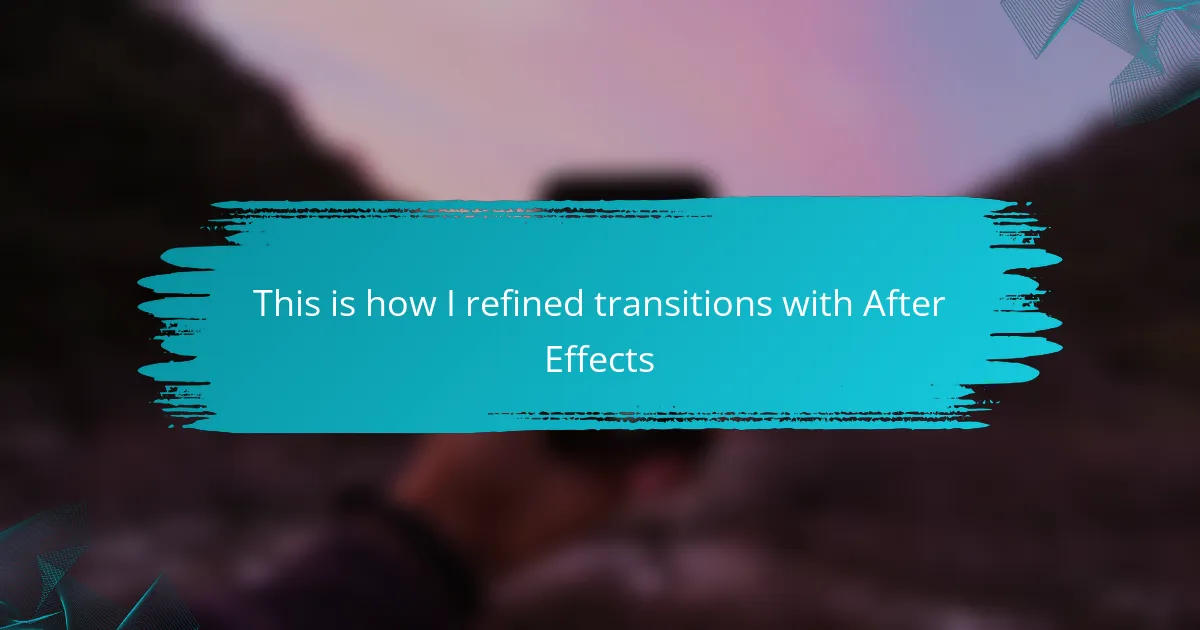Key takeaways
- After Effects enhances wedding videos by allowing for sophisticated visual effects and emotional transitions that deeply resonate with viewers.
- Subtle, consistent transitions such as fades and cross-dissolves improve storytelling and maintain the emotional flow of wedding highlights.
- Incorporating techniques like motion blur and sound layering enhances the viewer’s experience and creates a seamless narrative.
- Personalizing transitions to reflect the couple’s unique style and maintaining a cohesive visual theme is crucial for impactful wedding cinematography.
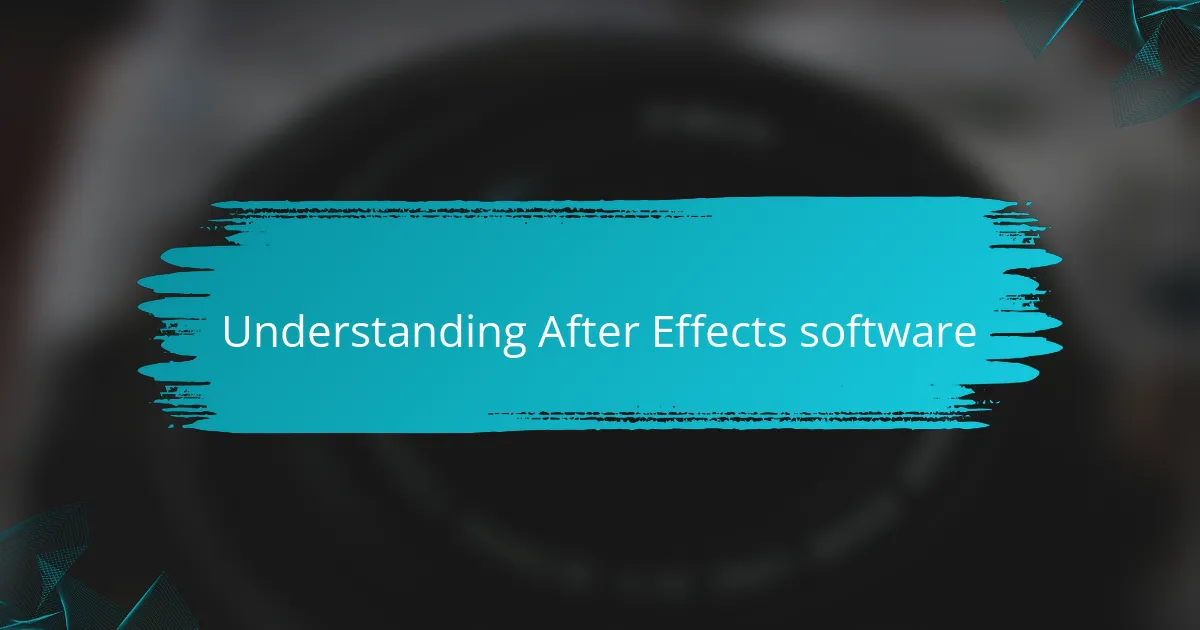
Understanding After Effects software
After Effects is a powerful software that allows creatives to add stunning visual effects and animations to their projects. I remember my early days diving into After Effects, feeling a mix of excitement and intimidation. The ability to refine transitions and elevate my wedding photography videos was a game changer, transforming simple clips into captivating stories.
Working with After Effects provides endless possibilities for customization. Whether it’s adding a subtle fade or a more dynamic transition, I found that experimenting with different effects enhances the emotional impact of the wedding moments I capture. It’s not just about making things look good; it’s about evoking feelings that resonate with couples when they relive their special day.
Here’s a quick comparison of After Effects with some other popular video editing tools:
| Software | Best For |
|---|---|
| Adobe After Effects | Advanced VFX and Animation |
| Adobe Premiere Pro | General Video Editing |
| Final Cut Pro | Mac Users, Fast Editing |
| DaVinci Resolve | Color Grading |
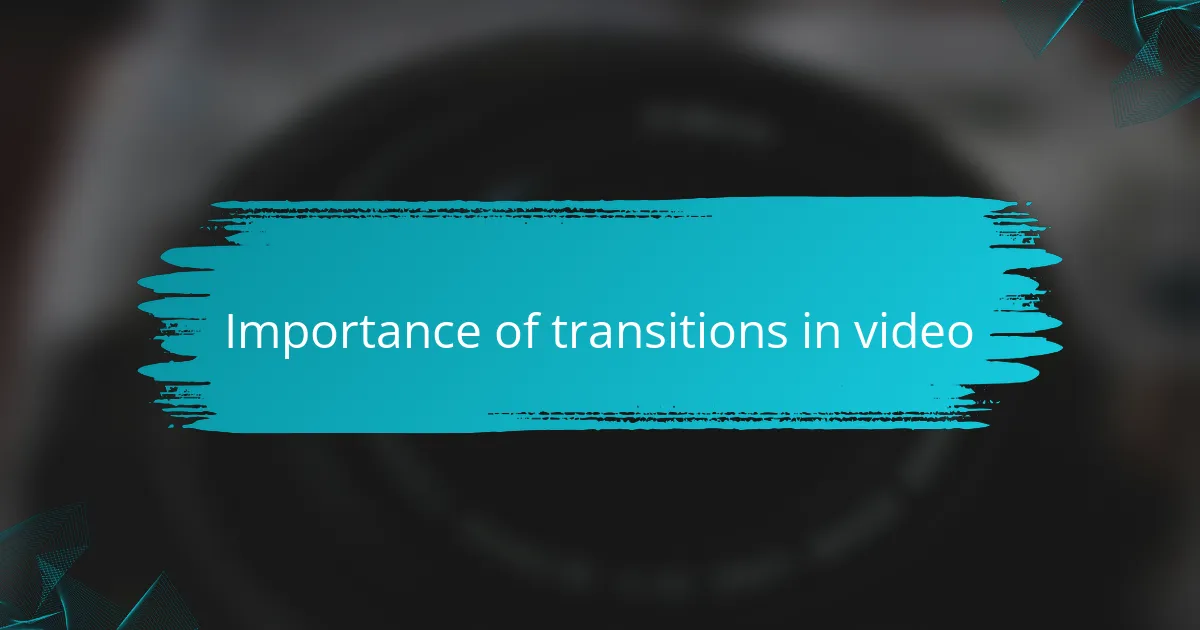
Importance of transitions in video
Transitions play a crucial role in video editing, especially in wedding photography. They don’t just connect scenes; they create an emotional flow that tells the couple’s story. I remember when I first edited a wedding highlight reel and realized how a simple fade could evoke nostalgia when moving from the ceremony to the reception.
Effective transitions can enhance the viewer’s experience in several ways:
– They maintain the storytelling pace, seamlessly guiding the audience through meaningful moments.
– They set the mood, using style and timing to elevate emotional impact.
– They draw attention to important details, emphasizing special events during the wedding day.
– They can reflect the couple’s personality, helping to create a unique visual style that resonates with viewers.
Incorporating thoughtful transitions can transform a collection of clips into a heartfelt narrative that brides and grooms will cherish for a lifetime.
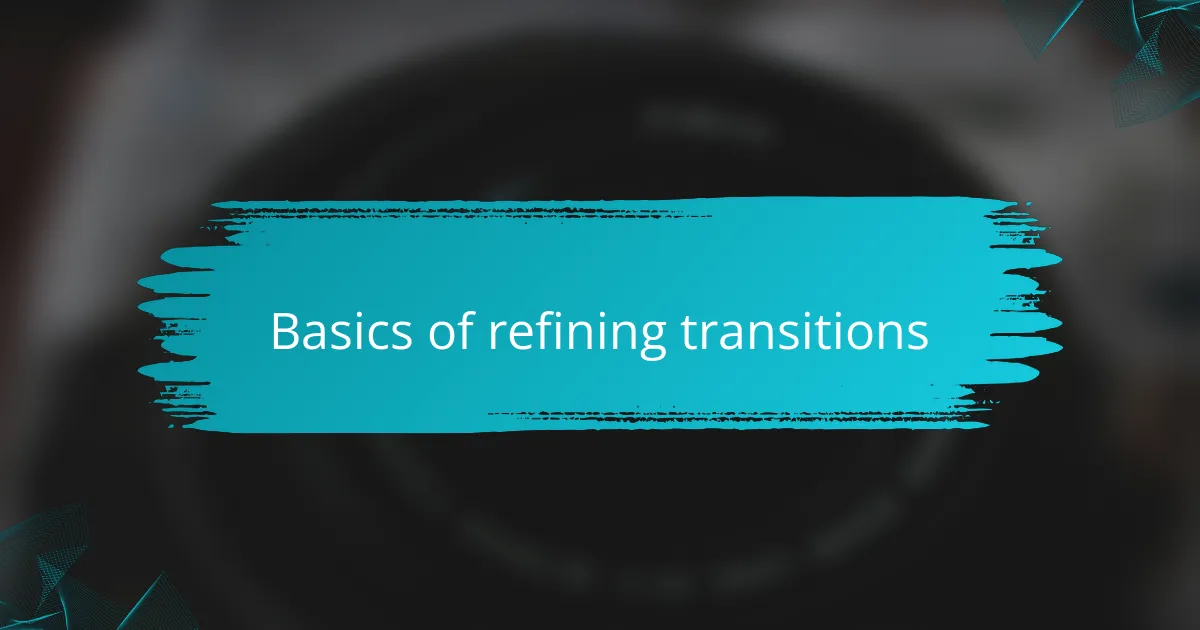
Basics of refining transitions
When it comes to refining transitions in After Effects, I’ve found that understanding the basics is crucial. I remember my early days of editing, where I relied heavily on standard transitions. They were functional, but lacked the emotional punch I wanted to convey in wedding highlights. By focusing on smoothing out the transitions, I noticed a significant improvement in how the story flowed, enhancing the overall viewing experience.
Another important aspect is the timing of your transitions. I’ve learned that too quick or too slow can break the mood. Finding the sweet spot allows the audience to absorb each moment, which is particularly vital in capturing the emotional essence of a wedding day.
Here’s a comparison of common transition types and their emotional impact:
| Transition Type | Emotional Impact |
|---|---|
| Fade | Creates a soft, gentle feeling, perfect for romantic moments. |
| Slide | Conveys movement and excitement, great for dynamic scenes. |
| Wipe | Can indicate change or progression, useful for storytelling. |
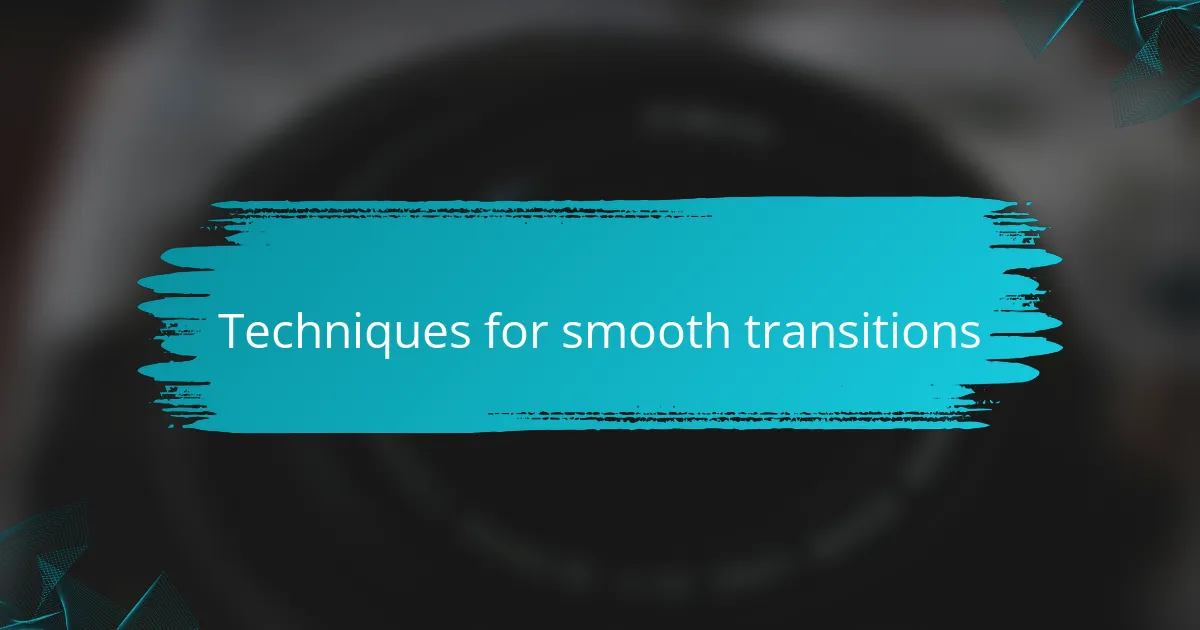
Techniques for smooth transitions
One technique I’ve found particularly effective is the use of motion blur during transitions. This subtle effect smooths out the jump between scenes and creates a flow that feels natural, much like how real life feels when you move your head quickly from one view to another. I remember experimenting with this while editing a couple’s first dance—adding motion blur gave the clip a dreamy quality, making it even more enchanting.
Another approach is layering sound transitions with visual changes. I’ve noticed that blending ambient audio—like laughter or music—helps to bridge the emotional gap between different clips. For instance, as I transitioned from the ceremony to the reception, using the sound of clinking champagne glasses layered under visuals of toasts helped to seamlessly shift the atmosphere while enriching the viewer’s experience.
Finally, incorporating keyframes for precise control over the transition’s speed can elevate the storytelling. I often utilize keyframes to gradually ramp up or slow down the transition effect. This technique allows me to synchronize the visuals with the rhythm of the music or the emotional beats of the video. When I first applied this method to a wedding highlight, I felt like I unlocked a new level of storytelling that truly captured the couple’s essence.
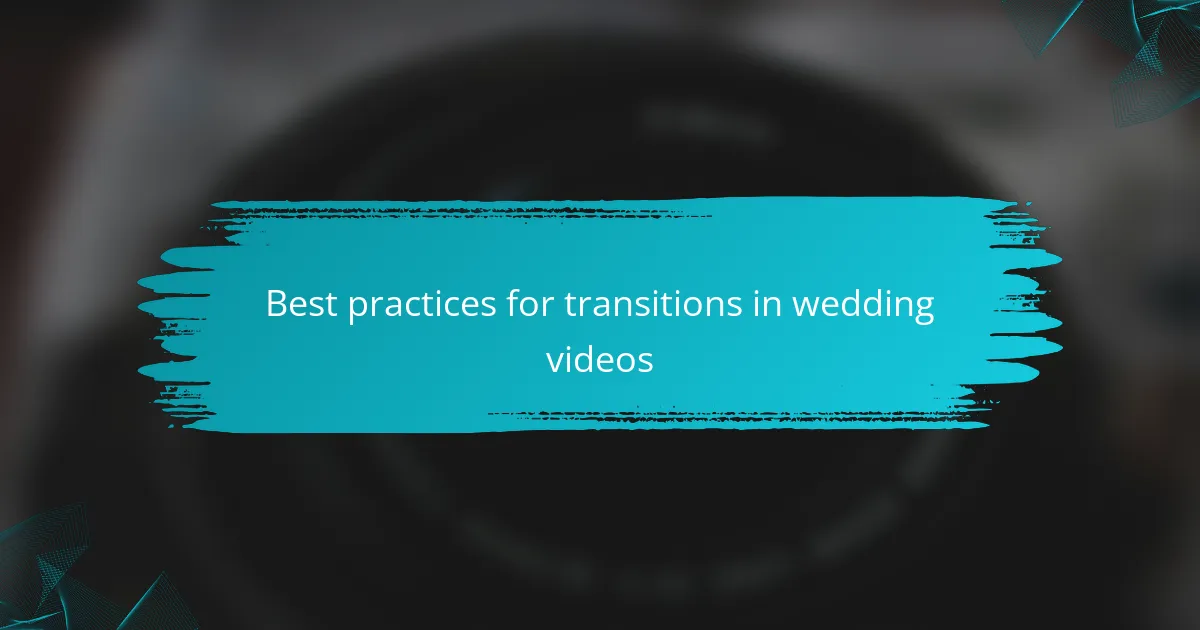
Best practices for transitions in wedding videos
When it comes to crafting beautiful wedding videos, transitions are the delicate threads that weave moments together. I’ve learned that subtlety is key; loud, flashy transitions can detract from the emotional weight of the day. For instance, using a simple fade or a gentle cross-dissolve often feels more organic, allowing the viewer to immerse themselves in each heartfelt moment without distraction.
Another best practice is to maintain a consistent style throughout the video. I once experimented with various types for a single project and found that it felt disjointed. Selecting a particular transition style helped unify the footage, creating a seamless storytelling experience that resonated with the couple’s emotions. It also helped in preserving the romantic ambiance that’s so crucial in wedding cinematography.
Ultimately, every transition choice should enhance the narrative, not overshadow it. I always ask myself, “Does this transition contribute to the story?” If not, it’s time to rethink it. Keeping this principle in mind has transformed the way I approach editing wedding videos, making them more cohesive and emotionally impactful.
| Transition Type | Best Use Case |
|---|---|
| Fade | Great for transitioning between significant moments or scenes. |
| Cross-dissolve | Can blend emotional highlights, like vows or speeches, smoothly. |
| Jump Cut | Effective for building energy, like during dancing or celebrations. |
| Wipe | Use sparingly; can add style but may distract if overused. |
| Slide | Ideal for moving from one location to another in a dynamic way. |
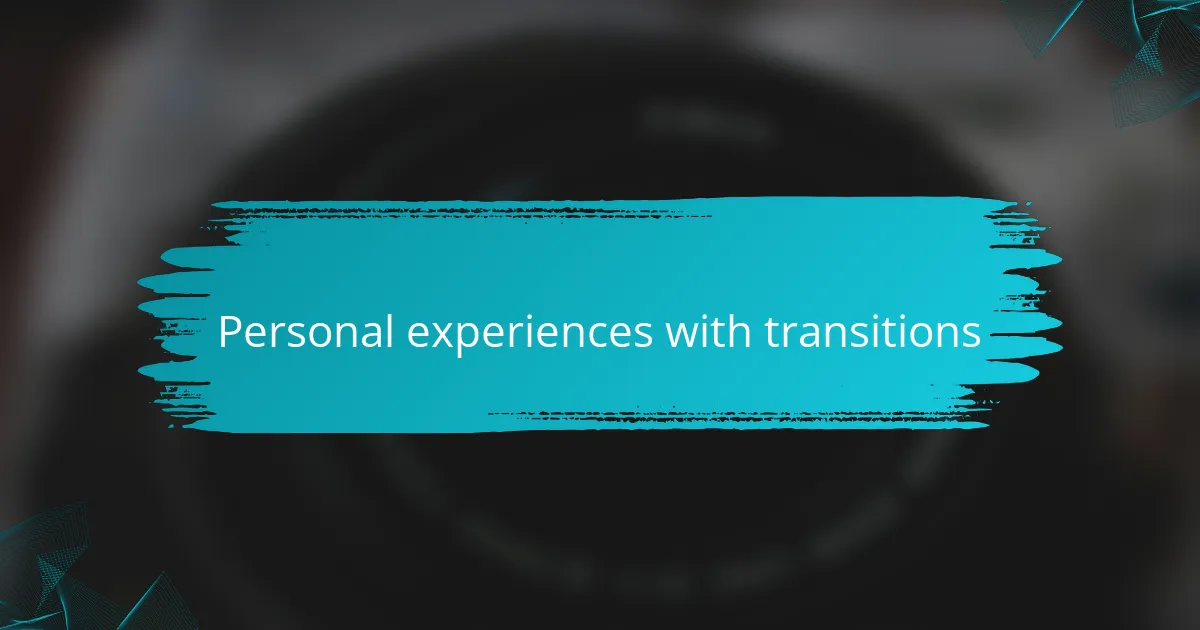
Personal experiences with transitions
When I first started using transitions in After Effects for wedding videos, I was amazed by the impact they had on storytelling. One memorable moment was when I applied a soft fade between clips of the ceremony and reception. It transformed the overall feel, creating a seamless flow that pulled the viewer into the emotion of the day.
As I honed my skills, I learned that subtle transitions often conveyed feelings better than flashy effects. For instance, using a slow cross-dissolve during romantic moments helped capture the intimacy. Reflecting on these experiences, I’m proud of how far I’ve come, especially when I see the emotional reactions from couples looking back on their special day.
| Type of Transition | Emotional Impact |
|---|---|
| Fade | Creates a smooth, gentle shift, often evoking nostalgia or romance. |
| Wipe | Brings energy and excitement, ideal for transitions between lively moments. |
| Zoom | Draws attention to details, enhancing the emotional weight of key moments. |
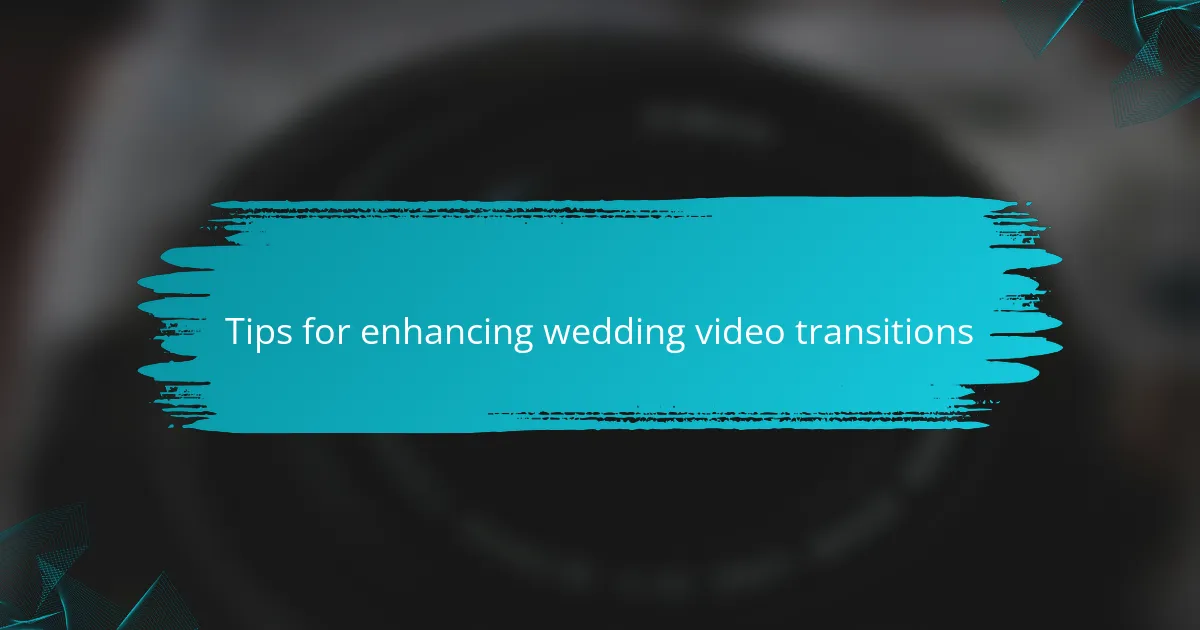
Tips for enhancing wedding video transitions
When enhancing wedding video transitions, one of the most effective strategies I’ve noticed is using color grading to match scenes. Imagine transitioning from the vibrant colors of an outdoor ceremony to the warm tones of an indoor reception. I once adjusted the color palette during the cuts, and it created a visual harmony that tied the different moments together beautifully. It’s this alignment that subtly guides the viewer, making them feel more connected to the story.
Additionally, I try to incorporate transitions that really reflect the couple’s personality. For example, I had a couple who loved vintage aesthetics, so I used film grain effects during transitions, which added a nostalgic feel that resonated with their story. It’s these kinds of thoughtful choices that leave a lasting impression, inviting viewers to experience their journey uniquely while simultaneously celebrating the couple’s individuality.
Consistency in the style of transitions can also make a huge difference. When I first edited a wedding video, I mixed too many transition styles, which ended up feeling chaotic. Now, I take the time to choose one or two styles and stick with them throughout the video. This not only maintains a cohesive look but also allows the emotional weight of the moments to shine through. When every element works together, the final product becomes a heartfelt narrative that couples will treasure for years to come.
